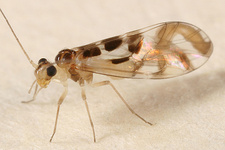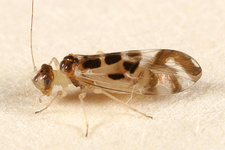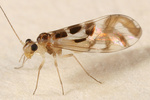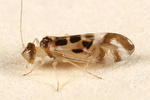Stenopsocidae
Emilie Bess and Kevin P. Johnson


This tree diagram shows the relationships between several groups of organisms.
The root of the current tree connects the organisms featured in this tree to their containing group and the rest of the Tree of Life. The basal branching point in the tree represents the ancestor of the other groups in the tree. This ancestor diversified over time into several descendent subgroups, which are represented as internal nodes and terminal taxa to the right.

You can click on the root to travel down the Tree of Life all the way to the root of all Life, and you can click on the names of descendent subgroups to travel up the Tree of Life all the way to individual species.
For more information on ToL tree formatting, please see Interpreting the Tree or Classification. To learn more about phylogenetic trees, please visit our Phylogenetic Biology pages.
close boxIntroduction
The family Stenopsocidae contains about 100 species in 4 genera distributed worldwide, with highest diversity in Asia. A few species of Graphopsocus are known from North America.
These are medium to large sized bark lice (3.5-5 mm, nymphs 2-3 mm). Body colors are brown and yellowish brown. Stenopsocids are known to inhabit damp forest, where they can be collected from green foliage.
Characteristics
Synapomorphies
- Forewing pterostigma and vein R are connected by crossvein.
- Areola postica is joined to vein M by a crossvein.
General Characters
- Head:
- Antennae have 13 segments.
- Legs:
- Tarsi have 2 segments.
- Wings:
- Forewing:
- Pterostigma and vein R are connected by crossvein.
- Areola postica is joined to vein M by a crossvein.
- Veins Rs and M usually fused for part of their length.
- Hindwing margin is hairless or has hairs in cell R3 only.
- Abdomen: Abdomen has 2 or 3 vesicles (inflatable sacs) on underside that
- excrete a sticky substance used to adhere insect to substrate.
- Male:
- Phallosome is closed, the tip has a rough texture.
- Hypandrium is simple, not ornamented.
- Female:
- Subgenital plate has a single lobe.
- Gonapophyses are reduced:
- Ventral valve is slender and tapered.
- Dorsal valve is slender and tapered.
- External valve is a small, sclerified, hairy lobe at base of dorsal valve.
- Eggs:
- Eggs are laid in groups and are covered by silken threads.
How to Know the Family
- Medium to large bark lice: 3.5-5 mm in length.
- Body colors are brown or yellowish brown.
- Abdomen has 2 or 3 vesicles (inflatable sacs) on ventral side
- Forewing pterostigma and vein R are connected by a crossvein.
- Areola postica is joined to vein M by a crossvein.
Family Monophyly
The monophyly of Stenopsocidae is well supported by three morphological features: presence in the forewing of a crossvein connecting the pterostigma with vein R, a crossvein connecting veins M+CuA1, and the presence of a lateral pouch of the spermathecal sac of the female (Yoshizawa 2002).
Discussion of Phylogenetic Relationships
Relationships within the family have not been investigated using molecular techniques.
References
Yoshizawa, K. 2002. Phylogeny and higher classification of suborder Psocomorpha (Insecta: Psocodea:'Psocoptera'). Zoological Journal of the Linnean Society 136: 371-400.
Title Illustrations

| Scientific Name | Graphopsocus cruciatus |
|---|---|
| Location | Dunstable, Ma. |
| Comments | 10/14/2007 |
| Specimen Condition | Live Specimen |
| Sex | m |
| Life Cycle Stage | adult |
| View | lateral |
| Copyright | © Tom Murray |
| Scientific Name | Graphopsocus cruciatus |
|---|---|
| Location | Dunstable, Ma. |
| Comments | 10/14/2007 |
| Specimen Condition | Live Specimen |
| Sex | f |
| Life Cycle Stage | adult |
| View | lateral |
| Copyright | © Tom Murray |
About This Page
Emilie Bess

Illinois Natural History Survey, Champaign, Illinois, USA
Kevin P. Johnson

Illinois Natural History Survey, Champaign, Illinois, USA
Correspondence regarding this page should be directed to Emilie Bess at
bess@inhs.uiuc.edu
and Kevin P. Johnson at
kjohnson@inhs.uiuc.edu
Page copyright © 2009 Emilie Bess and Kevin P. Johnson
All Rights Reserved.
- First online 25 March 2009
- Content changed 25 March 2009
Citing this page:
Bess, Emilie and Kevin P. Johnson. 2009. Stenopsocidae. Version 25 March 2009 (under construction). http://tolweb.org/Stenopsocidae/14468/2009.03.25 in The Tree of Life Web Project, http://tolweb.org/









 Go to quick links
Go to quick search
Go to navigation for this section of the ToL site
Go to detailed links for the ToL site
Go to quick links
Go to quick search
Go to navigation for this section of the ToL site
Go to detailed links for the ToL site